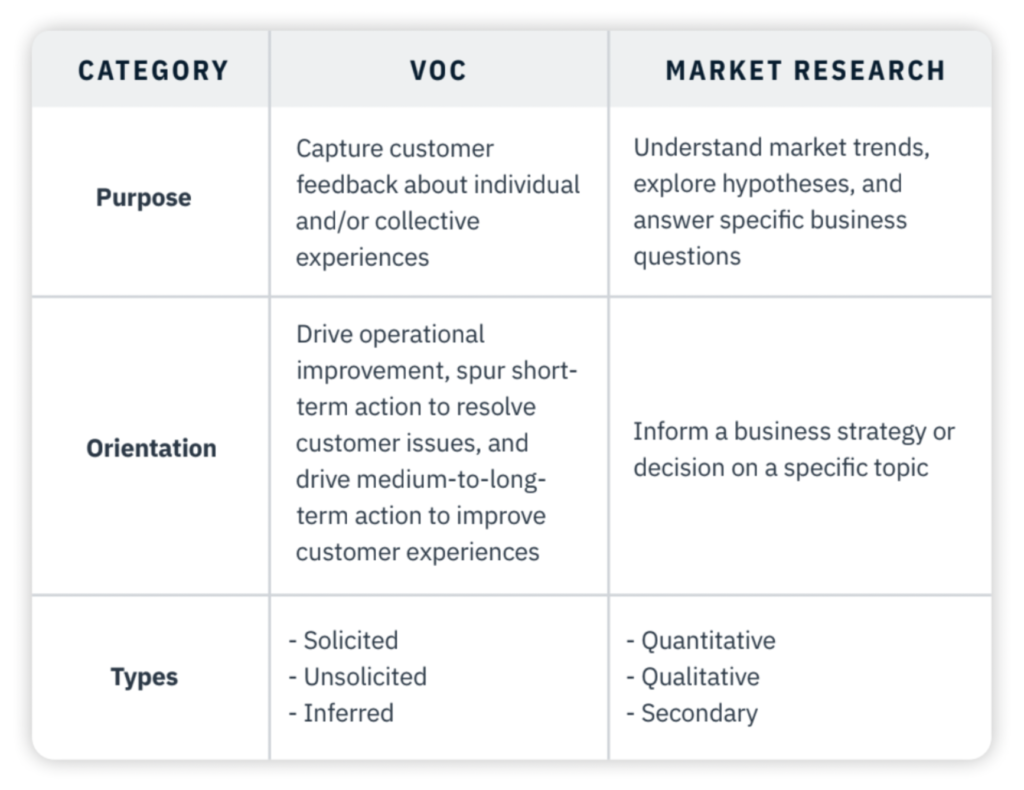
These days, understanding your customers isn’t a “nice thing to do”; it’s an absolute necessity. To truly understand your customers, you need to spend some quality time listening to them and understanding the voice of the customer. That’s why mastering the art of the voice of the customer survey can be a game-changer for any business seeking to better understand its customers. The power of listening to your customers transcends beyond just collecting feedback; it serves as a strategic compass, guiding your decision-making, shaping your product development, and, most importantly, building strong, lasting customer relationships.
Read on to learn more about voice of the customer surveys, why they’re so important, how to create them, and some sample questions that can get you started creating your VoC survey today.
What Is a Voice of the Customer Survey?
At its core, a voice of the customer (VoC) surveys captures customers’ expectations, preferences, and aversions toward products, services, or your company in general. A VoC survey involves gathering both quantitative and qualitative feedback from customers about their various touchpoints with a company. Touchpoints could be anything from an interaction with your website, chatting with your customer service representatives, or actually using your products and services. By exploring customers’ experiences with these touchpoints, you’ll gain a holistic understanding of your customer’s journey and experience with your company.
Why Are Voice of the Customer Surveys So Important?
A VoC is more than just another survey to worry about. The benefits of VoC surveys extend far beyond mere data collection. They provide invaluable insights that can shape product development, fine-tune marketing strategies, and enhance customer service. Hopefully with all of these pieces in place, you’ll experience improved customer satisfaction and loyalty. Thus, the power of VoC surveys lies not just in listening to what customers have to say but in using those insights to create a better, more personalized customer experience.
Let’s dive into three specific benefits from utilizing VoC surveys as the powerful they are:
Understanding Customer Needs and Wants
At the heart of any successful business strategy lies a deep understanding of customer needs and wants. VoC surveys are literally the voice of your customers. They serve as a way to pull out real and salient insights into your customers’ needs and wants. These insights are the pulse of the market, reflecting real-time customer sentiment and demand. By tuning into the voice of the customer, you can identify what truly matters to your customers and adjust your strategies, products, and services appropriately. Your customers love it too.. VOC surveys provide customers with the opportunity to communicate their needs and wants directly to businesses.
Improving Customer Satisfaction
You created your business to solve a problem, and you want to make sure your products and services are actually doing that. The way to see if you’re reaching your customers the way you want is to evaluate your customer satisfaction. A VoC survey gives you the chance to do just that. Plus using these surveys can also help you boost your customer satisfaction on its own. Customers love the opportunity to be heard and understood, so when you’re actively working toward that, they’re going to notice and appreciate that.
Improving the Business Overall
VoC surveys are not just about improving customer experience; they offer significant benefits for the overall health and growth of the business. These surveys help businesses pinpoint potential issues from the customer’s perspective, allowing them to proactively address these concerns before they escalate and cause significant damage. Whatever customers aren’t liking, with a VoC, you have a chance to stop that in its tracks. This proactive approach not only improves the customer experience but also strengthens the company’s reputation, enhances operational efficiency, and drives overall business success.
Designing Your Voice of the Customer Survey
Voice of the customer surveys are powerful. How do you go about creating your own? Let’s dive into some of the basic steps for designing a highly effective VoC survey.
Define Objectives
Before crafting your VoC survey, it’s crucial to define clear, specific objectives. What are you trying to do or understand? Are you looking for insights on a specific product or service you want to refine? Or are you looking to improve your customer satisfaction overall? Knowing what your objectives are will help you design a survey that gathers data to help with your goal. You can ensure the data you collect is actionable and relevant to your overall business goals.
Choose the Right Types of Questions
Once you have clear objectives, you need questions that achieve your overall goals. The choice of questions in your VoC survey can significantly impact the quality and type of feedback you receive. To gain a comprehensive understanding of your customers’ experiences, it’s advisable to use a mix of multiple choice questions, scales (like the Likert scale), and open-ended questions. Multiple choice questions and scales are excellent for collecting quantitative data, offering clear, easily analyzable feedback. On the other hand, open-ended questions allow customers to express their opinions and experiences in their own words, providing rich qualitative data that can offer deeper, nuanced insights. A mix of question types will give you deeper insights overall.
Keep It Simple
While it’s important to gather as much valuable feedback as possible, your customers won’t complete a long survey. It’s much better to have fewer questions and more complete surveys than the other way around. Aim to keep it simple and keep your surveys no longer than 10 minutes. The simpler and more streamlined your survey, the more likely customers are to complete it and provide honest, thoughtful responses.
Start Broad, Then Get Specific
When structuring your VoC survey, a useful approach is to start with general questions before delving into more specific ones. Starting broad helps your customers “warm up” to providing you with feedback. Broad, initial questions can pertain to overall satisfaction, general experiences, or perceptions of your brand. Essentially, your early questions should be easy to answer without too much extensive thought. You can narrow as you go to get more detailed feedback.
Questions to Ask in a Voice of the Customer Survey
Those strategies can help you get started. To really take your VoC survey to the next level, we have some starter questions to help you write your own voice of the customer surveys. The questions we provide are broken up into general categories that you may want to consider on your surveys.
Value-Based VoC Questions
- Did you find everything you were looking for today?
- Is there anything you were looking for that we didn’t have?
- On a scale of 1-10, how would you rate the value of your purchase?
- What are the most important qualities you look for in a product or service? (This question is particularly poignant as a multiple choice question)
- Did our customer service help you resolve any issue you came across?
Brand Loyalty VoC Questions
- How likely are you to recommend our brand to a friend or colleague on a scale of 1–10?
- When thinking about our brand, product, or service, what is the first thing that comes to mind?
- What might prevent you from doing business with us in the future?
- How likely are you to switch to a different brand, product, or service?
Customer Satisfaction Questions
- How would you describe your experience with us today?
- How satisfied are you with the product or service you received?
- Was your customer service agent able to handle any issue you had?
- What could we have done to improve your experience?
Final Thoughts
Overall, VoC surveys are powerful tools to better understand your customers and how they really perceive your company. Utilizing these surveys, you can further refine your products and services, enhance your customer satisfaction, and better meet the needs of your customers.
Learn more about how a voice of the customer survey can help you build a better brand with InMoment today!




